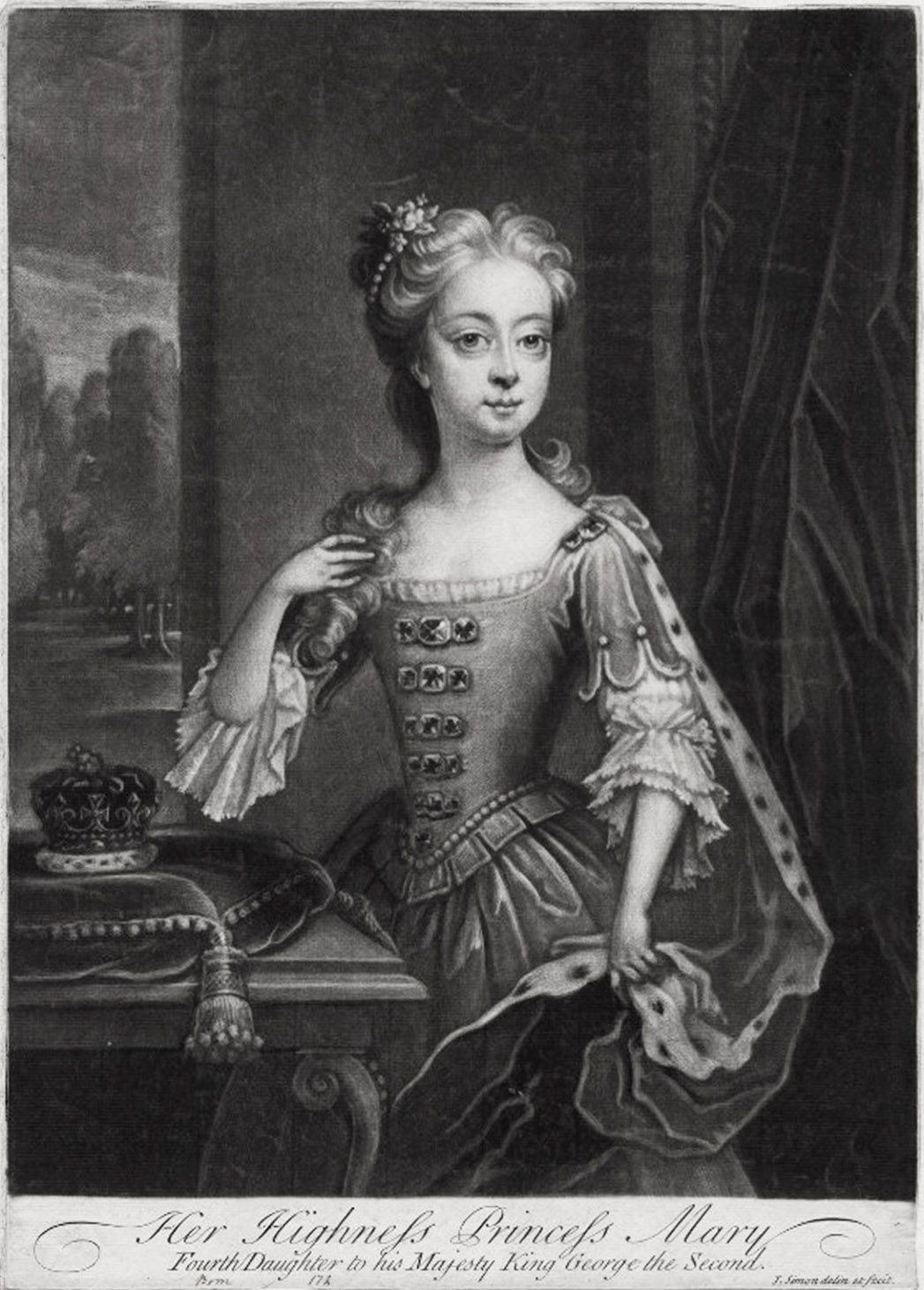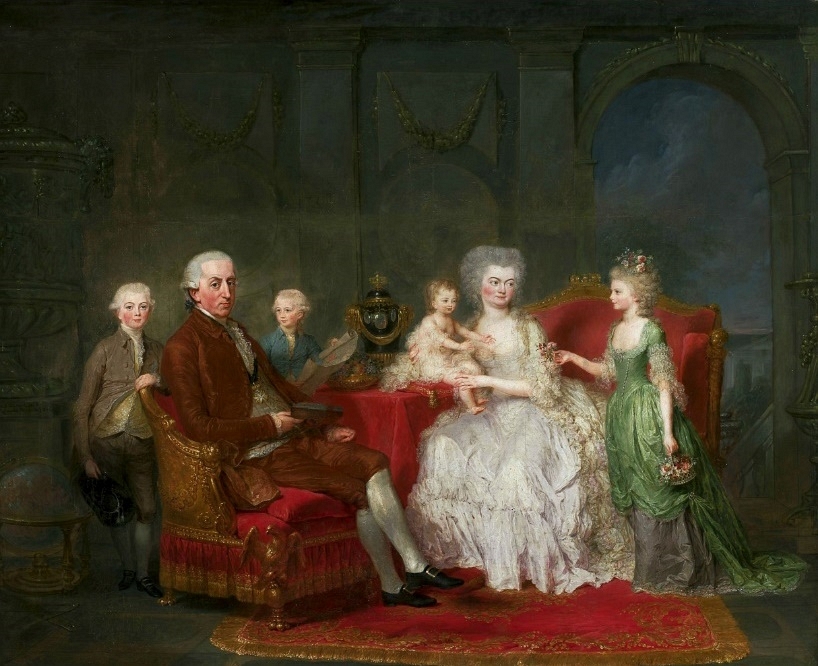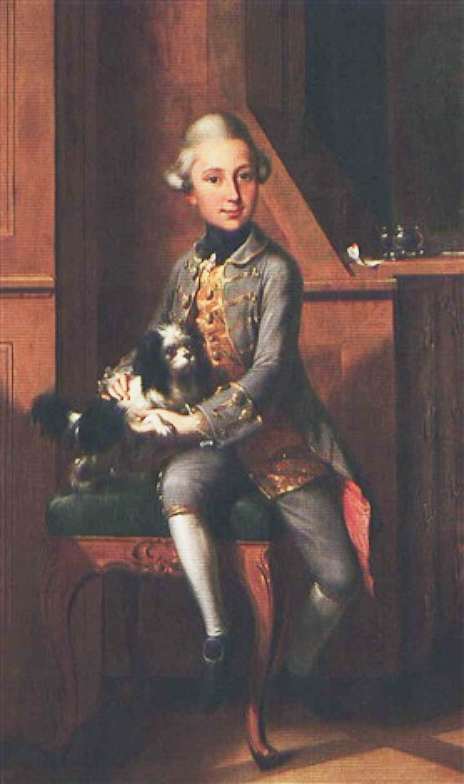|
Princess Marie Frederica Of Hesse-Kassel
, house = Hesse-Kassel , father = William II, Elector of Hesse , mother = Princess Augusta of Prussia , birth_date = , birth_place = Kassel , death_date = , death_place = Meiningen, Thüringen, Germany } Princess Marie Frederica Wilhelmina of Hesse-Kassel (6 September 1804 – 1 January 1888) was a Duchess consort of Saxe-Meiningen by marriage to Bernhard II, Duke of Saxe-Meiningen. She was the daughter of William II, Elector of Hesse and Princess Augusta of Prussia. Life Marie Frederica was one of six children born to William II, Elector of Hesse by his first spouse Augusta of Prussia. However, her only sibling to live past the age of five was Frederick William, Elector of Hesse. In addition, she had eight half-siblings by her father's second marriage to Emilie Ortlöpp, Countess of Reichenbach-Lessonitz. Duchess In 1822, Marie, through the suggestion of her mother's friend, the Swedish countess Charlotta Aurora De Geer, was considered a ... [...More Info...] [...Related Items...] OR: [Wikipedia] [Google] [Baidu] |
Duke Of Saxe-Meiningen
Saxe-Meiningen (; german: Sachsen-Meiningen ) was one of the Saxon duchies held by the Ernestine duchies, Ernestine line of the House of Wettin, Wettin dynasty, located in the southwest of the present-day Germany, German state of Thuringia. Established in 1681, by partition of the Ernestine duchy of Saxe-Gotha among the seven sons of deceased Duke Ernest I, Duke of Saxe-Gotha, Ernst der Fromme (Ernest the Pious), the Saxe-Meiningen line of the House of Wettin lasted until the end of the German monarchies in 1918. History House of Wettin The House of Wettin, Wettiner had been the rulers of sizeable holdings in today's states of Saxony, Saxony-Anhalt and Thuringia since the Middle Ages. In the ''Treaty of Leipzig, Leipziger Teilung'' of 1485, the Wettiner were split into two branches named after their founding princes Albert III, Duke of Saxony, Albrecht and Ernest, Elector of Saxony, Ernst (''albertinisch'' and ''ernestinisch''). Thuringia was part of the Ernestine holdings of ... [...More Info...] [...Related Items...] OR: [Wikipedia] [Google] [Baidu] |
Princess Charlotte Of Prussia (1831–1855)
Life Family and early years Her parents' marriage was unhappy due to Prince Albert's several affairs, and finally was dissolved on 28 March 1849, after which Princess Marianne began to live with her former coachman Johannes van Rossum, with whom she had a son, Johannes William of Reinhartshausen. The custody of Charlotte and her two surviving siblings Albert and Alexandrine was given to their father; however, their childless aunt Queen Elisabeth Ludovika took care of them, moreover after Prince Albert's second and morganatic marriage in 1853 with Rosalie von Rauch, who bore him two sons, Count William and Count Frederick of Hohenau. Marriage As a young woman, Charlotte was highly eligible, due to her Dutch fortune and Hohenzollern connections. In Charlottenburg on 18 May 1850, the nineteen-year-old princess married Georg, Hereditary Prince of Saxe-Meiningen, who was twenty-four years old. The only son of Bernhard II, Duke of Saxe-Meiningen and Princess Marie of Hesse-Kassel, h ... [...More Info...] [...Related Items...] OR: [Wikipedia] [Google] [Baidu] |
Duchess Luise Of Brunswick-Wolfenbüttel
Duchess Luise of Brunswick-Wolfenbüttel (Luise Amalie; 29 January 1722 – 13 January 1780) was daughter of Ferdinand Albert II, Duke of Brunswick-Wolfenbüttel and his wife Duchess Antoinette of Brunswick-Wolfenbüttel. Background She was born at the Schloss Bevern near Holzminden/Weser. She was the seventh of fourteen children. Her parents were second cousins. Marriage On 6 January 1742 she married Prince Augustus William of Prussia, second son of King Frederick William I of Prussia and Sophia Dorothea of Hanover. Prince Augustus William was a younger brother of the reigning Frederick the Great, whose spouse, Luise's own sister, gave him no children. As such, her son was to inherit the Prussian throne in 1786. In her widowhood, she was given the Crown Prince's Palace in Berlin. Family Her older sister was Queen Elisabeth Christine of Prussia, wife of her brother-in-law Frederick the Great. She was also the sibling of Queen Juliana Maria of Denmark and Norway and Cha ... [...More Info...] [...Related Items...] OR: [Wikipedia] [Google] [Baidu] |
Prince Augustus William Of Prussia
Prince Augustus William of Prussia (german: August Wilhelm; 9 August 1722 – 12 June 1758) was a son of King Frederick William I of Prussia and a younger brother and general of King Frederick II (Frederick the Great). Augustus was the second surviving son of Frederick William I and Sophia Dorothea. His older siblings included Wilhelmina (later Margravine of Bayreuth), Frederick II (later King of Prussia), Friedrike Louise (later Margravine of Ansbach) and Louisa Ulrika (later Queen consort of Sweden). Augustus was favored by his father over Frederick and popular at the Prussian court. When his brother Frederick became king in 1740, Augustus became heir presumptive and moved into Fredrick's former residence, the Crown Prince's Palace in Berlin. When his older sister Louisa Ulrika married the King of Sweden in 1744, she founded the Ordre de l'Harmonie, of which Augustus was one of the first recipients. Augustus served his brother as a general in the War of the Austrian Succ ... [...More Info...] [...Related Items...] OR: [Wikipedia] [Google] [Baidu] |
Louise Of Great Britain
Louise of Great Britain (originally Louisa; 1724 – 19 December 1751) was Queen of Denmark and Norway from 1746 until her death, as the first wife of King Frederick V. She was the youngest surviving daughter of King George II of Great Britain and Caroline of Ansbach. The marriage between Louise and Frederick V of Denmark was arranged solely for political reasons (King George's ministers wanted Danish support in disputes with Prussia). Although the marriage was arranged, the couple got along quite well, at least during the first years of marriage. Louisa, who encouraged performances by actors and musicians, was a popular figure at the Danish court even though she never exerted significant influence over her husband's decision-making. Early years Princess Louise was born as the fifth daughter and youngest child of the then Prince and Princess of Wales, on 1724, at Leicester House, Westminster, London. She was born ten years after her paternal grandfather, Elector George Lou ... [...More Info...] [...Related Items...] OR: [Wikipedia] [Google] [Baidu] |
Frederick V Of Denmark
Frederick V (Danish and Norwegian: ''Frederik V''; 31 March 1723 – 14 January 1766) was King of Denmark–Norway and Duke of Schleswig-Holstein from 6 August 1746 until his death in 1766. He was the son of Christian VI of Denmark and Sophie Magdalene of Brandenburg-Kulmbach. Although the personal influence of Frederick was limited, his reign was marked by the progress of commerce and trade, and art and science prospered under his reign. Unlike his parents who were deeply devoted to Pietism, Frederick grew into a hedonist. As regent, he took part in the conduct of government by attending council meetings, but he was afflicted by alcoholism and most of his rule was dominated by able ministers who were influenced by the ideas of the Age of Enlightenment. His ministers marked his reign by the progress of commerce and the emerging industry. They also avoided involving Denmark-Norway in the European wars of his time. Although Frederick V wasn't personally interested in cultural affai ... [...More Info...] [...Related Items...] OR: [Wikipedia] [Google] [Baidu] |
Princess Mary Of Great Britain
Princess Mary of Great Britain (5 March 1723 – 14 January 1772) was the second-youngest daughter of George II of Great Britain and his wife, Caroline of Ansbach, and Landgravine of Hesse-Kassel as the wife of Frederick II, Landgrave of Hesse-Kassel. Early life Princess Mary was born at Leicester House, Westminster, London. Her father was the Prince of Wales, later King George II. Her mother was Caroline of Ansbach, daughter of Johann Friedrich, Margrave of Brandenburg-Ansbach. Her father succeeded, as George II, on 11 June 1727, and she became "HRH The Princess Mary". Upon her death in 1737, her mother, Queen Caroline, entrusted Mary to her elder sister Caroline, urging her to "do what she could to support the meek and mild disposition of Princess Mary". Marriage A marriage was negotiated with Landgrave Frederick of Hesse-Kassel, the only son and heir of William VIII, Landgrave of Hesse-Kassel. For the marriage, Parliament voted Mary £40,000. They married by proxy at t ... [...More Info...] [...Related Items...] OR: [Wikipedia] [Google] [Baidu] |
Frederick II, Landgrave Of Hesse-Kassel
Frederick II (german: Landgraf Friedrich II von Hessen-Kassel) (14 August 1720 – 31 October 1785) was Landgrave of Hesse-Kassel (or Hesse-Cassel) from 1760 to 1785. He ruled as an enlightened despot, and raised money by renting soldiers ( called "Hessians") to Great Britain to help fight the American Revolutionary War. He combined Enlightenment ideas with Christian values, cameralist plans for central control of the economy, and a militaristic approach toward international diplomacy. Early life Frederick was born at Kassel in Hesse, the son of William VIII, Landgrave of Hesse-Kassel and his wife Dorothea Wilhelmine of Saxe-Zeitz. His paternal grandfather was Charles I, Landgrave of Hesse-Kassel, and his paternal uncle was Frederick I of Sweden. His education was initially entrusted to Colonel August Moritz von Donop and then from 1726 to 1733 to the Swiss theologian and philosopher, Jean-Pierre de Crousaz. Marriages and children On 8 May 1740, by proxy in London, and on 28 ... [...More Info...] [...Related Items...] OR: [Wikipedia] [Google] [Baidu] |
Frederica Louisa Of Hesse-Darmstadt
Frederica Louisa of Hesse-Darmstadt (german: Friederike Luise; 16 October 1751 – 25 February 1805) was Queen of Prussia as the second spouse of King Frederick William II. Life Frederica Louisa was the daughter of Louis IX, Landgrave of Hesse-Darmstadt, and Countess Palatine Caroline of Zweibrücken. She was born in Prenzlau. She was the sister of Grand Duchess Louise of Saxe-Weimar-Eisenach, as well as Grand Duke Louis I of Hesse. Marriage Frederica Louisa was selected to marry Frederick William immediately after his divorce from Elisabeth Christine of Brunswick-Lüneburg, after Margravine Philippine of Brandenburg-Schwedt and Sophia Albertina of Sweden had been suggested. Her mother was highly admired by Frederick the Great. The wedding was performed on 14 July 1769 at the Charlottenburg Palace. Frederica Louisa was described as solid and sensible and with an agreeable conversation, though lacking of beauty and any particular intellectual abilities.Atkinson, Emma Wi ... [...More Info...] [...Related Items...] OR: [Wikipedia] [Google] [Baidu] |
Frederick William II Of Prussia
Frederick William II (german: Friedrich Wilhelm II.; 25 September 1744 – 16 November 1797) was King of Prussia from 1786 until his death in 1797. He was in personal union the Prince-elector of Brandenburg and (via the Orange-Nassau inheritance of his grandfather) sovereign prince of the Canton of Neuchâtel. Pleasure-loving and indolent, he is seen as the antithesis to his predecessor, Frederick the Great. (Frederick II). Under his reign, Prussia was weakened internally and externally, and he failed to deal adequately with the challenges to the existing order posed by the French Revolution. His religious policies were directed against the Enlightenment and aimed at restoring a traditional Protestantism. However, he was a patron of the arts and responsible for the construction of some notable buildings, among them the Brandenburg Gate in Berlin. Haydn, Mozart and Beethoven all dedicated works to him. Early life Frederick William was born in Berlin, the son of Prince Augus ... [...More Info...] [...Related Items...] OR: [Wikipedia] [Google] [Baidu] |
Princess Wilhelmina Caroline Of Denmark
german: Wilhelmina Karolina , house = Oldenburg , father =Frederick V of Denmark , mother =Louise of Great Britain , birth_date = , birth_place =Christiansborg Palace, Copenhagen, Denmark , death_date = , death_place =Kassel, Germany , religion = Lutheranism Princess Wilhelmina Caroline of Denmark and Norway ('' da, Vilhelmina Karoline, german: Wilhelmina Karolina'') (10 July 1747 in Christiansborg Palace, Copenhagen – 14 January 1820 in Kassel), was the Landgravine consort of Hesse-Kassel and later the Electress of Hesse-Kassel by marriage to William I, Elector of Hesse. Life Early life Princess Wilhelmina Caroline was born on 10 July 1747 at Christiansborg Palace, the recently completed principal residence of the Danish Monarchy on the island of Slotsholmen in central Copenhagen. She was the third child and second daughter of King Frederick V of Denmark (1723–1766), and his first spouse Queen Louise (1724–1751), daughter of King Geo ... [...More Info...] [...Related Items...] OR: [Wikipedia] [Google] [Baidu] |
William I, Elector Of Hesse
William I, Elector of Hesse (german: link=no, Wilhelm I., Kurfürst von Hessen; 3 June 1743 – 27 February 1821) was the eldest surviving son of Frederick II, Landgrave of Hesse-Kassel (or Hesse-Cassel) and Princess Mary of Great Britain, the daughter of George II. Biography Early life Prince William was born on 3 June 1743 in Kassel, capital of the Landgraviate of Hesse-Kassel in the Holy Roman Empire. Born into the House of Hesse, he was the second but eldest surviving son of Prince Frederick of Hesse-Kassel (the future Landgrave Frederick II), and his wife Princess Mary of Great Britain. A former heir to the landgraviate, also named William, had died in infancy in 1742; therefore, hopes were high for the future of the new heir apparent. He had two younger brothers: Prince Charles and Prince Frederick. His father's marriage with the British princess was not a happy one, and Frederick abandoned the family in 1747 and converted to Catholicism in 1749. In 1755 he formally an ... [...More Info...] [...Related Items...] OR: [Wikipedia] [Google] [Baidu] |








